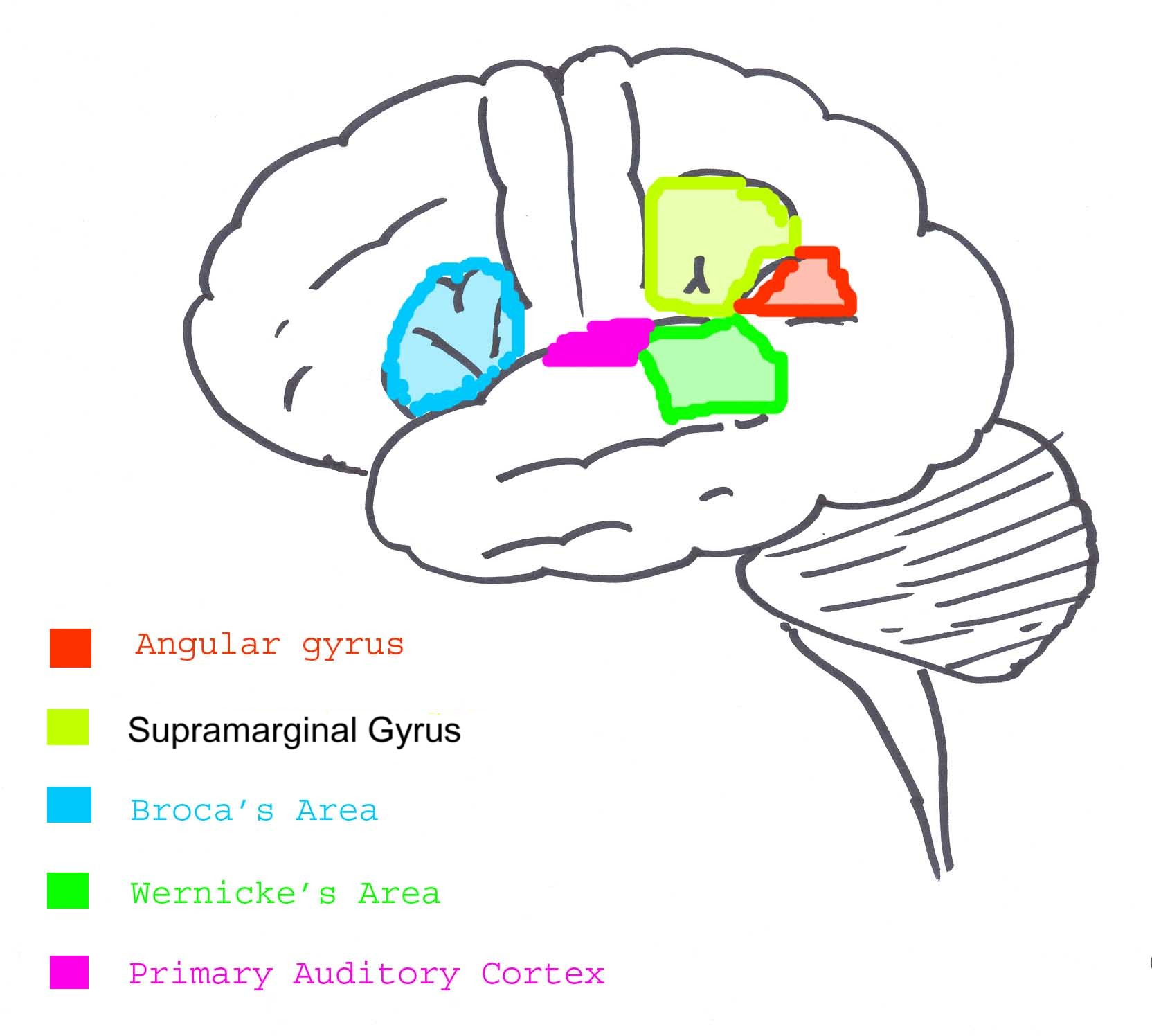This essay focuses on language acquisition
Its purpose is to distinguish between different approaches to L1 and L2 acquisition, to explain the most important theories on acquisition, paying attention especially to generativism and emergentism. Before beginning to talk about acquisition theories, I would like to give an explanation on how the brain works. Where is memory located in the brain? How does the brain memorize words? How do we acquire and remember names, images, songs and so on?
The human brain is formed by two cerebral hemispheres
the right one and the left one, which are broadly similar in shape and are connected to each other. They have different tasks: the right side thinks in a holistic way, it is able to manage a lot of input at the same time and it is responsible for gestural communication and for visual memory. On the other hand, the left side deals with one input at a time. It processes information in a linear way, and it contains regions which are involved in speech and language: like Broca’s area, which controls language enunciation and Wernicke’s area, which is involved in language comprehension. Differences between the two hemispheres regard also other cognitive activities, like memory, for example. Procedural, semantic and situational memories involve the left side; whereas visual, spatial and emotive memories involve the right side one. In regard to language, the left-hand hemisphere is dominant: in fact, in a 3-month-old baby the lateralization of the brain has already occurred. Steinberg (1997) explains lateralization as follows:
“the brain assigns, as it were, certain structures and functions to certain hemispheres of the brain. Language, logical and analytical operations, and higher mathematics, for example, generally occur in the left hemisphere of the brain, while the right hemisphere is superior at recognizing emotions, recognizing faces and taking in the structures of things globally without analysis. This separation of structure and function in the hemispheres is technically referred to as lateralization”.
“The memory is a mental process of storage and retrieval of information and experience”. (Parente and Stapleton, 1993) During the memorizing process information is first received through senses, then it is stored temporarily in short-term memory (STM). After that, the brain carries the information to the structural core where it is compared with other information and stored in the long-term memory (LTM).

According to a most recent researches
in scientific word, information which comes from sensitive areas is first sent to the limbic system then to the thalamus to the base of the forebrain and finally to the pre-frontal cortex. Information travels towards the opposite direction and the continued movement makes it move from the STM to the LTM. Having illustrated how the brain works, I will now turn to the difference between language acquisition and language learning. Acquisition does not require extensive use of conscious grammatical rules, but meaningful interaction in the target language, in which speakers are concerned not in the form of their utterances, but with the message they are conveying and understanding. According to the online Miriam-Webster dictionary the following definition is given for the verb to acquire: “to come to have as a new or additional characteristic, trait, or ability”. Children acquire a language without explicit teaching “on the basis of positive evidence (i.e, what they hear), under varying circumstances, and in a limited amount of time, in identical ways across different languages” (Hamman, 1986). Furthermore, there are two kinds of evidence: positive and negative evidence.
“The positive evidence comes from the speech learners hear/read and thus is composed of a limited set of well-formed utterances of the language being learned. When a particular sentence type is not heard, one does not know whether it is not heard because of its impossibility in the language or because of mere coincidence. It is in this sense that the sentences of a language that provide the input to the learner are known as positive evidence.” (Gass & Selinker; 1994)
Moreover, the baby by the age of 5 has mastered most of the constructions of his/her language whereas the vocabulary is still growing. Language learning, instead, is explained in the Miriam Webster dictionary as follows: “the activity or process of gaining knowledge or skill by studying, practicing, being taught, or experiencing something.” Language learning as seen today is not communicative. It is the result of direct instructions about the rules of language and certainly it is not an age-appropriate activity for young learners – as it is not for adults either. In language learning, students have conscious knowledge of the new language and can talk about that knowledge. If we want to give a rough distinction between acquisition and learning: we could say that the first one is implicit, subconscious. Also, it requires grammatical notions and depends on attitude. The second, instead is explicit, conscious, requires the use of grammatical rules and the order of learning is from simple to complex order of learning.
Krashen’s hypothesis
For a more accurate explanation I would like to focus my attention to Krashen’s hypothesis, who concentrates his study on second language acquisition. Krashen (1981) begins his work in the following ways:
“This book is concerned with what has been called the “Monitor Theory” of adult second language acquisition. Monitor Theory hypothesises that adults have two independent systems for developing ability in second languages, subconscious language acquisition and conscious language learning.”
Hamman (1986) in turn, maintains that acquiring a language, which is the basis for all L1 language learning, is a subconscious process, “it’s the act of internal in language to which an acquirer has been exposed without the deliberate memorisation of a word and its definition.” According to Krashen,
“Language acquisition is very similar to the process children use in acquiring first and second languages. It requires meaningful interaction in the target language-natural communication. Acquirers need not have a conscious awareness of the “rules” they possess, and may self-correct only on the basis of a “feel” for grammaticality.”
Children acquire language when they are able to understand something that is above their level of understanding. Moreover, other factors play an important role in language acquisition, for example production should not be forced. Students should be as relaxed as possible and error correction is not useful for keeping the affective filter high. Conversely, learning is a conscious activity since, it refers to knowledge or language forms which are represented in the learner’s mind. This process implies formal instruction and it is less effective than acquisition. First language acquisition (FLA) is one of the most important issues in psycholinguistics be investigated in the last decades: “Acquisition is the process by which human beings acquire the capacity to perceive and comprehend language, as well as to produce and use words and sentences to communicate.“ (David, 2007:325).
When linguists talk about first language acquisition
they refer to the native language that people learn to speak from when they were born. Acquiring a language means to acquire the phonology, morphology, syntax, semantics and vocabulary of that language. L1 speakers are both linguistically and communicatively proficient in their native language, which means, on one hand, that they naturally know the rules of their language, can use them properly and tell what is wrong from what is right. On the other hand, native speakers learn it in a spontaneous way and know intuitively sociolinguistic functions.
Bibliografia
- Gass S.M and Selinker (1994) Second language acquisition. An introductory course.
- Hamman C. (1986) Language Acquisition
- Mochi S. (2008) ‘Linguistics and the Lexicon in Second Language Acquisition.’ In Perpsective, Volume XXXV, n. 1, 2008
- Zascerinska J. Language acquisition and language learning: developing the system of external and internal perspective. Paper presented at the 52nd International Scientific Conference of Daugavpils University, Daugavpils, Latvia. April 15, 2010.
Sitografia
- https://www.trainingindustry.com/content-development/articles/how-the-brain-arns.aspxhttp://www.memorydr.com/memory.htm
- http://www.merriam-webster.com/dictionary/acquire http://languagedevelopment.tripod.com/id16.html https://www.ncbi.nlm.nih.gov/pmc/articles/PMC3723803/









